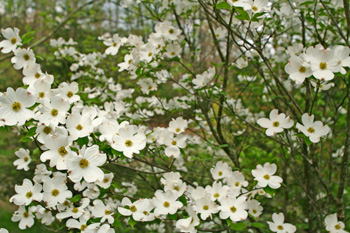Contents:
Common Names | Parts Usually Used | Plant(s) & Culture | Where Found | Medicinal Properties | Biochemical Information
Legends, Myths and Stories | Uses | Formulas or Dosages | Warning | Bibliography
Scientific Names

- Cornus florida L.
- Cornaceae
- Cornus family
Common Names
- American dogwood
- Boxwood
- Budwood
- Cornelian Tree
- Dogtree
- False Box
- Florida cornel
- Florida dogwood
- Flowering cornel
- Flowering dogwood
- Green Ozier
- Virginia dogwood
Parts Usually Used
Inner bark, berries, twigs
Back to Top
Description of Plant(s) and
Culture
Dogwood is a native American, our most showy deciduous tree, growing to 30 feet high; the bark is brown and rough, the leaves opposite, ovate, pointed, and darker green above than beneath. Latex threads appear at veins when leaves are split apart. The flowers are small and greenish-yellow but are obscured by the large, white or pink bracts so that the whole looks like a large white or pink flower. Flowers are in clusters, April-May. The fruit is a glossy, dry, scarlet berry two celled and two seeds, is inedible and very bitter; October-November.
Other varieties: Chinese dogwood (Cornus machrophylla), Chinese name Sung-yang; in Japan this tree is Celtis muku or Ehretia serrata; Jamaican dogwood (Piscidia erythrina) used medicinally for panic attacks and excessive stress; and Osier dogwood (Cornus stolonifera) used by the Native Americans, the inner bark has properties of quinine used as tea internally.
Back to Top
Where Found
Found from Maine to Florida and west to Minnesota, Kansas, and Texas.
Grows in the understorey of woods, along roadsides and in old fields
Back to Top
Medicinal Properties
Astringent, febrifuge, stimulant, tonic
Back to Top
Biochemical Information
Tannic and gallic acids, resin, gum, oil, wax, lignin, lime potash and iron
Back to Top
Legends, Myths and Stories
Widely used in the South, especially during the Civil War for malarial fevers and chronic diarrhea.
An 1830 herbal reported that the Native Americans and captive Africans in Virginia were remarkable for the whiteness of their teeth, and attributed it to the use of Dogwood chewing sticks. Once chewed for a few minutes, the tough fibers at the ends of the twigs split into a fine soft “brush”. Also, the Native American tribe, the Arikaras, mixed bearberry with the dried inner bark of the red dogwood to make sacred tobacco which they smoked in a regulation red pipestone pipe.
Back to Top
Uses
Dogwood bark is best used as an ointment for ague, malaria (substitute for quinine), fever, pneumonia, colds, and similar complaints. Used for diarrhea. Externally, poulticed onto external ulcers and sores. Twigs used as chewing sticks, forerunners of the toothpick. It was sometimes used as a substitute when Peruvian bark could not be obtained.
Back to Top
Formulas or Dosages
Use only dried dogwood bark. Fresh bark upsets the stomach and bowels.
Infusion: steep 1 tbsp. bark in 1 pint water for 30 minutes and strain. Take 1/2 cup every 2-3 hours.
Tincture: take 20-40 drops in water, as needed.
Back to Top
Warning
As with hard toothbrushes, dogwood chewing sticks can cause receding gums.
Back to Top
Bibliography
![]() The Herb Book
The Herb Book, by John Lust, Bantam Books, 666 Fifth Avenue, New York, NY. copyright 1974.
![]() The Complete Medicinal Herbal
The Complete Medicinal Herbal, by Penelope Ody, Dorling Kindersley, Inc, 232 Madison Avenue, New York, NY 10016, First American Edition, copyright 1993
![]() Chinese Medicinal Herbs
Chinese Medicinal Herbs, compiled by Shih-Chen Li, Georgetown Press, San Francisco, California, 1973.
![]() Indian Uses of Native Plants
Indian Uses of Native Plants, by Edith Van Allen Murphey, Meyerbooks, publisher, PO Box 427, Glenwood, Illinois 60425, copyright 1958, print 1990
![]() Eastern/Central Medicinal Plants
Eastern/Central Medicinal Plants, by Steven Foster and James A. Duke., Houghton Mifflin Company, 215 Park Avenue South, New York, NY 10000
![]() Planetary Herbology
Planetary Herbology, by Michael Tierra, C.A., N.D., O.M.D., Lotus Press, PO Box 325, Twin Lakes. WI 53181., Copyright 1988, published 1992
![]() Indian Herbalogy of North America
Indian Herbalogy of North America, by Alma R. Hutchens, Shambala Publications, Inc., Horticultural Hall, 300 Massachusetts Avenue, Boston, Massachusetts 02115, 1973
![]() American Folk Medicine
American Folk Medicine, by Clarence Meyer, Meyerbooks, publisher, PO Box 427, Glenwood, Illinois 60425, 1973
 Prairie Smoke
Prairie Smoke, by Melvin R. Gilmore, Minnesota Historical Society Press, St. Paul, Minnesota 55101, copyright 1987.
![]() Webster’s New World Dictionary
Webster’s New World Dictionary, Third College Edition, Victoria Neufeldt, Editor in Chief, New World Dictionaries: A Division of Simon & Schuster, Inc., 15 Columbus Circle, New York, NY 10023
 How Indians Use Wild Plants for Food, Medicine & Crafts
How Indians Use Wild Plants for Food, Medicine & Crafts, by Frances Densmore, Dover Publications, Inc., 180 Varick Street, New York, NY 10014, first printed by the United States Government Printing Office, Washington, in 1928, this Dover edition 1974
 An Instant Guide to Medicinal Plants
An Instant Guide to Medicinal Plants, by Pamela Forey and Ruth Lindsay, Crescent Books (January 27, 1992).
 The Rodale Herb Book: How to Use, Grow, and Buy Nature’s Miracle Plants (An Organic gardening and farming book)
The Rodale Herb Book: How to Use, Grow, and Buy Nature’s Miracle Plants (An Organic gardening and farming book), edited by William H. Hylton, Rodale Press, Inc. Emmaus, PA, 18049., 1974
